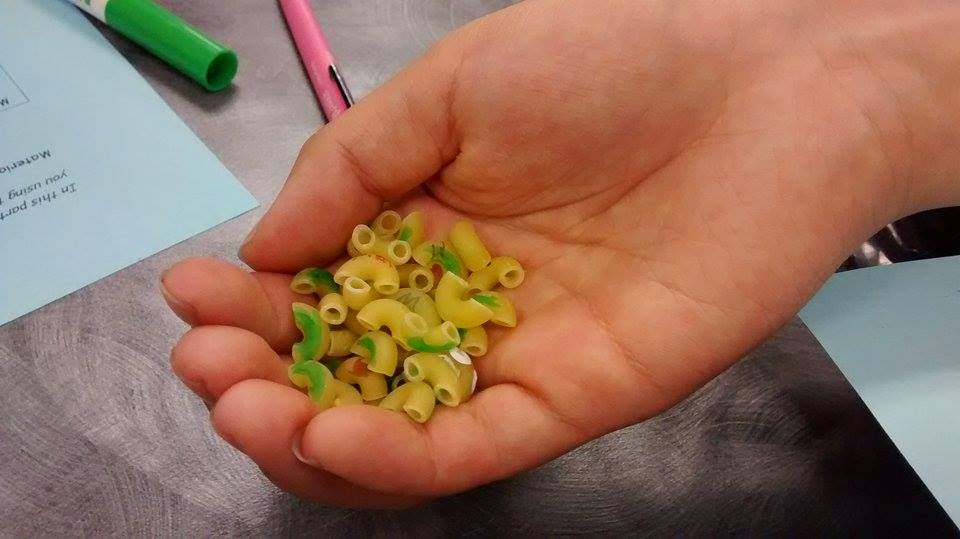- 1 bag of uncooked pasta
- Sharpie markers
Methods:
Trial #1
1. Capturing of the pasta population
2. Marking the captured population
Number of pasta caught and marked in first sample: 40
Number of pasta caught and marked in first sample: 40
3. Releasing of marked and captured pasta population, and mixed with general population
4. Taking another sample with eyes closed and recording how much was in the sample and how many of them were marked
Number of pasta caught in second try: 52
Number of marked pasta caught: 4
Number of pasta caught in second try: 52
Number of marked pasta caught: 4
5. Estimate of population calculations:
M/N = m/n, where M is the number of pasta caught and marked in first sample, N is total population, m is number of marked pasta caught in second sample, and n is the number of second sample
40/N = 4/52
40 = 4/52 x N
40 x 52/4 = N
There for N = 520
M/N = m/n, where M is the number of pasta caught and marked in first sample, N is total population, m is number of marked pasta caught in second sample, and n is the number of second sample
40/N = 4/52
40 = 4/52 x N
40 x 52/4 = N
There for N = 520
Trial #2:
1. Capture of the pasta population
Number of pasta caught: 90
2. Marking population
4. Capturing pasta for the second time with eyes closed
Number of pasta caught: 28
Number of marked pasta recaptured: 5
5. Estimate of population size for trial #2
M/N = m/n, where M is the number of pasta caught and marked in first sample, N is total population, m is number of marked pasta caught in second sample, and n is the number of second sample
90/N = 5/28
90 = 5/28 x N
90 x 28/5 = N
There for N = 504
Trial #3:
1. Capture of pasta population
Number of pasta caught: 33
2. Marking the captured population
3. Releasing the marked pasta back to the general population and randomly mixing it
4. Randomly capturing pasta with eyes closed, and recording how much was captured and how many marked pasta were recaptured
Number of captured pasta: 50
Number of marked pasta: 2
5. Estimate of population calculations:
M/N = m/n, where M is the number of pasta caught and marked in first sample, N is total population, m is number of marked pasta caught in second sample, and n is the number of second sample
33/N = 2/50
33 = 2/50 x N
33 x 50/2 = N
There for N = 825
% error = (theoretical - experimental) / theoretical
= (543 - 616) / 543
=13.4%
Analysis:
- Out of the three trials, the first trial was the closets, with an estimate of 520.
- The problems that might affect the accuracy of my estimate may have been the number of pasta that we took out of the bag the first time and the number of pasta that we took out the second time to see how many pastas we recaptured.
Problems that ecologists studying animal populations encounter may be that the animals may have been smarter than they have anticipated, and that the animal that they have marked may have had figured a way to remove the mark that had been put on them. An example of this is that dolphins help one another to remove the marker that was put on them, or they rub it against something that would have been able to help them get rid of it. - An improvement that my group could have is that we could have captured around the same amount that we captured the first time, because during the first capture we would take a big hand full, but then when it was the second try, we took a small hand full, so it was inconsistent. Also it would more accurate if we were to do more trials, so that the % error would be less.

















No comments:
Post a Comment